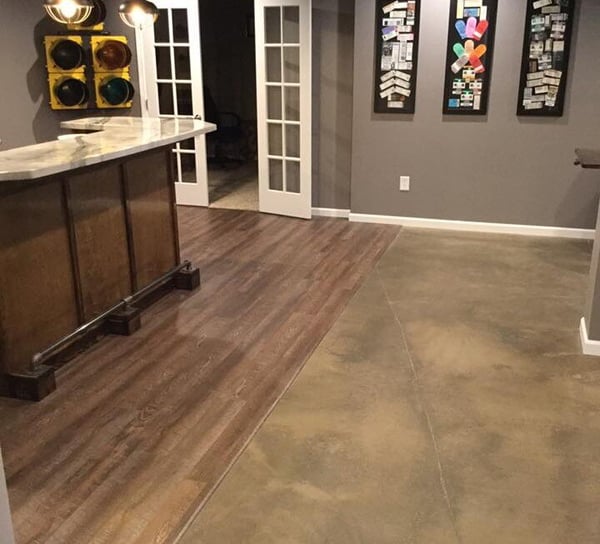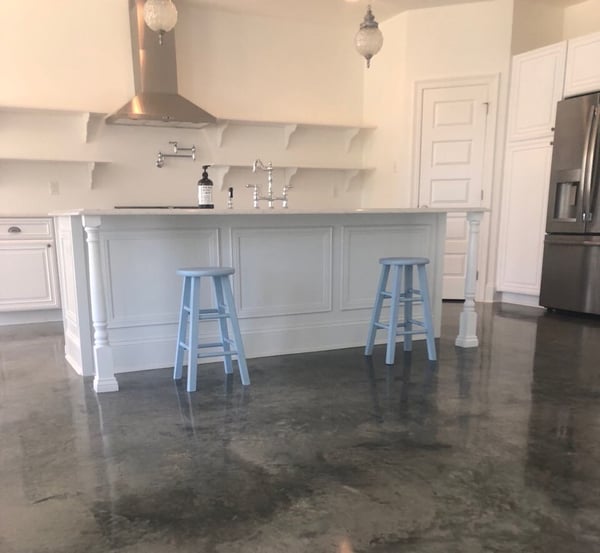Concrete is a strong and affordable construction material that can be used in a variety of applications.
As a result, it’s no surprise that concrete surfaces are found in many homes and businesses across the country. However, not all concrete surfaces are created equal. In addition to peeling paint, flooding humidity can also take a toll on concrete, especially if it’s left untreated.
Over time and with continued exposure to moisture, your concrete surface may appear dingy or even begin to crack and break off completely. Fortunately, several concrete resurfacing options are available – each of which has its own set of pros and cons.
The best concrete resurfacing option will depend on the condition of your existing concrete, the look you are trying to achieve, and your budget. If you have minor cracks or surface damage, concrete polishing may be all that is needed to restore the beauty of your concrete. Concrete resurfacing may be necessary for more significant damage, such as large cracks or holes.
In this article, you will learn about the different ways you can restore your old concrete surfaces back to life again, so they look new again!
What Is Concrete Resurfacing?
Concrete resurfacing is a process in which concrete is restored to its previous form following damage that occurred due to age, weather, or improper installation.
This is accomplished by removing the deteriorated concrete and replacing it with new material – such as a concrete overlay, epoxy, polymer concrete, or acrylic concrete. This can be done in a single day and can restore the surface to its original strength, coloring, and texture.
Concrete resurfacing allows you to get the most out of your existing concrete surface by covering up any cracks, spalling, or other damage. This can make your surface much easier to clean and maintain, which can be especially beneficial in situations where you would need to regularly wash a larger area of concrete.
Concrete repair or resurfacing can also help you save time and money by avoiding the need to tear out and replace the entire surface.

Concrete Resurfacing Options
Concrete patio, concrete flooring, garage floor, and concrete driveway resurfacing can be completed using a variety of materials. A concrete resurfacing product is typically chosen based on the damage's severity and the finished product's desired look and feel.
Several concrete resurfacing options are available, each of which has its own benefits and drawbacks. In order to determine which type of resurfacing is best for you, it’s important to understand the pros and cons of each.
Concrete Overlay
Sound concrete that just needs a face-lift: A thin concrete overlay may be all you need to give your patio, flooring, garage, or driveway a fresh look. Resurfacing material is available in a variety of colors, designs, and textures. You can also find an overlay that simulates the look of stone or brick.
Concrete Restoration
Concrete restoration is the process of removing the entire concrete surface and replacing it with a new material. This is typically only done in situations where the concrete is severely damaged. For example, if you have large cracks in your concrete or the surface has begun to flake off, concrete restoration may be the best option for you.
During concrete restoration, the entire concrete surface is removed and then replaced with fresh concrete that has been poured into place. This is often done by hiring a concrete contractor to install a new concrete surface, or a contractor may use an overlay to apply the new material.
Concrete overlays are a type of material that is applied to the surface without removing the existing concrete. This is often done using a spray application, a process that is commonly used to rehabilitate basketball courts.
Concrete Repaving
Concrete repaving is best suited for applications where the entire concrete surface must be replaced. Unfortunately, this is often the case with driveways and parking lots, where the concrete has been severely damaged over time.
However, it can also be used in situations where the concrete is in otherwise good condition but is discolored or has a poor texture.
During concrete repaving, the concrete is dug up, broken into pieces, and then replaced with new concrete. This can be done by pouring fresh concrete into place, a process that can be very time-consuming.
Alternatively, it can be done by repaving, which involves removing the damaged concrete and pouring new concrete over the surface. This method is much faster and is often completed in one day.
Concrete Honing And Polishing
Honing and polishing is a concrete resurfacing option that involves removing and replacing the damaged concrete with new material.
However, when honing and polishing, the new material is applied as a liquid and is then removed once it has been set up. This allows the concrete to be polished, which makes it much easier to clean.
Honing and polishing are best suited for concrete that is in otherwise good condition but has a stained surface or undesirable texture. For example, if you have concrete that is stained from oil, honing and polishing may be the best option for you.
Concrete Coating & Encapsulation
Concrete coating and encapsulation are similar to concrete restoration in that they involve removing the entire concrete surface and replacing it with new material. However, concrete coating and encapsulation are applied as a liquid, which allows them to adhere more tightly to the concrete surface.
This not only makes them more aesthetically appealing but also provides protection against minor damage, such as small cracks.
Concrete coating and encapsulation are best suited for concrete that is in otherwise good condition but has been stained or discolored by something like oil. They are also ideal for concrete that has a texture that needs to be improved, such as concrete that is too smooth.

Concrete Resurfacing With Acrylic Reconstruction
Concrete resurfacing with acrylic reconstruction is a process in which the concrete surface is completely removed and replaced with new material.
This is often done in situations where the concrete is severely damaged, such as when it has been stained by oil or another type of substance. During concrete resurfacing with acrylic reconstruction, the concrete is removed, the sub-surface is cleaned, and then new concrete material is poured into place.
This is often done by a contractor who uses a concrete pump to transport the new concrete to the surface. Once the concrete has been set up, it can be polished to remove any remaining marks from the removal process.
Concrete Resurfacing With Epoxy Reconstruction
Concrete resurfacing with epoxy reconstruction is a process similar to that of concrete resurfacing with acrylic reconstruction. However, in this case, the concrete is not removed, but the surface is instead coated with a thick layer of epoxy.
This is often done with driveways and parking lots prone to oil stains. Epoxy can be used to seal the oil and prevent it from spreading to the rest of the concrete.
Epoxy is applied as a liquid and allowed to set up, forming a thick layer that protects the concrete surface from further damage as well as making cleanup easier. Epoxy can also be used to improve the texture of the concrete, creating a surface that is easier to walk on.

Things To Consider Before Resurfacing Concrete
There are a few things to keep in mind before resurfacing concrete.
Determine The Extent Of The Damage
First, it is important to determine the extent of the damage. If the damage is minor, such as small cracks or stains, resurfacing may not be necessary.
However, resurfacing will be necessary if the damage is more severe, such as large cracks or holes.
Cost
It is also important to consider the cost of resurfacing.
Resurfacing can be expensive, so it is important to get an estimate from a contractor before proceeding. Concrete slabs may also need to be replaced, which will add to the cost.
Time
Another thing to consider is the time required for resurfacing.
Resurfacing can take a few days or even weeks, depending on the extent of the damage. Unfortunately, this means the area will need to be closed off during this time, which can be disruptive.
Aesthetics
Finally, it is important to consider the aesthetics of resurfacing. If you are resurfacing concrete that will be visible to others, such as a driveway or sidewalk, you will want to choose a resurfacing option that will improve the appearance of the concrete.
Concrete resurfacing is a great way to improve the look of your home while also protecting it from further damage. There are many different resurfacing options available, so be sure to consult with a contractor to find the best option for your needs.

Concrete Resurfacer
A concrete resurfacer is a material that is applied to the surface of the concrete to improve its appearance and protect it from damage.
Resurfacers are available in both liquid and powder forms. They are typically made from acrylic or epoxy, which are applied as a liquid or powder and allowed to be set up.
Once set, resurfacers form a tough, durable surface on the concrete slab that can withstand heavy traffic and protect the concrete from stains and other damage.
The best concrete resurfacer should be easy to apply, durable, and able to improve the appearance of concrete. Shrinkage compensated repair material is also a good option for concrete resurfacing.
Summary
Concrete is a strong and affordable construction material that can be used in a variety of applications.
While it is a great material for floors, walls, or any other construction project, concrete can become damaged over time. Concrete resurfacing is a process in which concrete is restored to its previous form following damage that occurred due to age, weather, or improper installation.
This can be accomplished by replacing the deteriorated concrete with new material, such as a concrete overlay, epoxy, polymer concrete, or acrylic concrete. This can be done in a single day and can restore the surface to its original strength, coloring, and texture.
Your concrete resurfacing project can be completed in a single day, and you will have a like-new surface that is both strong and attractive. Be sure to consult with a professional to find the best concrete resurfacing option for your needs

0 comments